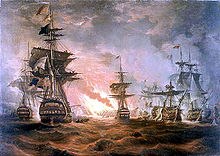- Missa in angustiis
-
Die Missa in angustiis (Messe in der Bedrängnis; auch Nelson-Messe, Hob. XXII: 11) in d-Moll ist die 11. Messkomposition von Joseph Haydn (1732-1809) aus dem Jahre 1798. Sie wurde im selben Jahr in Eisenstadt uraufgeführt.
Inhaltsverzeichnis
Hintergrund
Haydn schrieb die Messe für seinen langjährigen Auftraggeber und Patron Fürst Esterhazy. Wie ihr Name („Messe in der Bedrängnis“) sagt, entstand die Messe in einer sehr schwierigen Zeit, nämlich in der Zeit der napoleonischen Kriege, der sogenannten „Franzosenzeit“. Das zeigt sich auch darin, dass dies die einzige Messe Haydns ist, welche in einer Moll-Tonart verfasst ist. Außerdem besteht die Besetzung zusätzlich aus drei Trompeten, da der Fürst seine Holzbläser entlassen hatte. Die ursprüngliche Besetzung war somit: Streicher, Trompeten, Orgel und Pauken. Haydn ergänzte später Holzbläser- und Hörnerstimmen.
Die Messe umfasst klassisch Kyrie, Gloria, Credo, Sanctus, Benedictus und Agnus Dei. Sie weist viele düster klingende Momente auf, interessanterweise aber auch jubelnde Trompetenfanfaren.
Beiname
Sie verdankt ihren Beinamen dem Umstand, dass der britische Admiral Horatio Nelson auf seiner Rückreise von der siegreichen Seeschlacht vor Alexandria (bei Abukir), wo er die französische Flotte nahezu vernichtete, dem Fürst Nikolaus II. Esterházy einen Besuch abstattete, wobei ihm (Lord Nelson) zu Ehren diese Messe aufgeführt wurde.
Eine andere Legende besagt, dass Haydn während der Arbeit an der Messe erfuhr, dass Nelson Napoleon bei Abukir geschlagen hatte. Darauf führt man auch die Trompetenfanfaren innerhalb des Benedictus zurück.
Aufbau
Die Messe ist sechsteilig angelegt:
- 1. Kyrie eleison. Allegro moderato. Sopran solo, Chor und Orchester (Tutti)
- 2. Gloria in excelsis Deo. Allegro. Soli SATB, Tutti
- 3. Qui tollis. Adagio. Soli SB, Tutti
- 4. Quoniam to solus sanctus. Allegro . Soli SATB, Tutti
- 5. Credo in unum Deum. Allegro con spirito. Tutti
- 6. Et incarnatus est. Largo. Soli SATB, Tutti
- 7. Et resurrexit. Vivace. Sopran solo, Tutti
- 8. Sanctus. Adagio – Allegro. Tutti
- 9. Benedictus. Allegretto - Allegro. Soli SATB, Tutti
- 10. Agnus Dei. Adagio. Soli SATB
- 11. Dona nobis pacem. Allegro vivace. Tutti
Siehe auch
- Missa in tempore belli (Paukenmesse)
Literatur
- H. C. Robbins Landon, Missa in Angustiis d-Moll "Nelson-Messe", Hob. XXII:11, Studienpartitur, Verlag Eulenburg
Weblinks
- Gemeinfreie Noten von Missa in angustiis in der Choral Public Domain Library (ChoralWiki) (englisch)
- Beschreibung der Nelsonmesse bei Vocalino.
- Beschreibung der Lateinischen Messen beim Carus-Verlag.
Missa brevis F-Dur | Missa Sunt bona mixta malis | Missa Rorate coeli desuper | Große Orgelsolomesse | Cäcilienmesse | Nikolaimesse | Kleine Orgelsolomesse | Mariazellermesse
Die sechs späten Messen: Paukenmesse | Heiligmesse | Nelsonmesse | Theresienmesse | Schöpfungsmesse | Harmoniemesse
Wikimedia Foundation.

